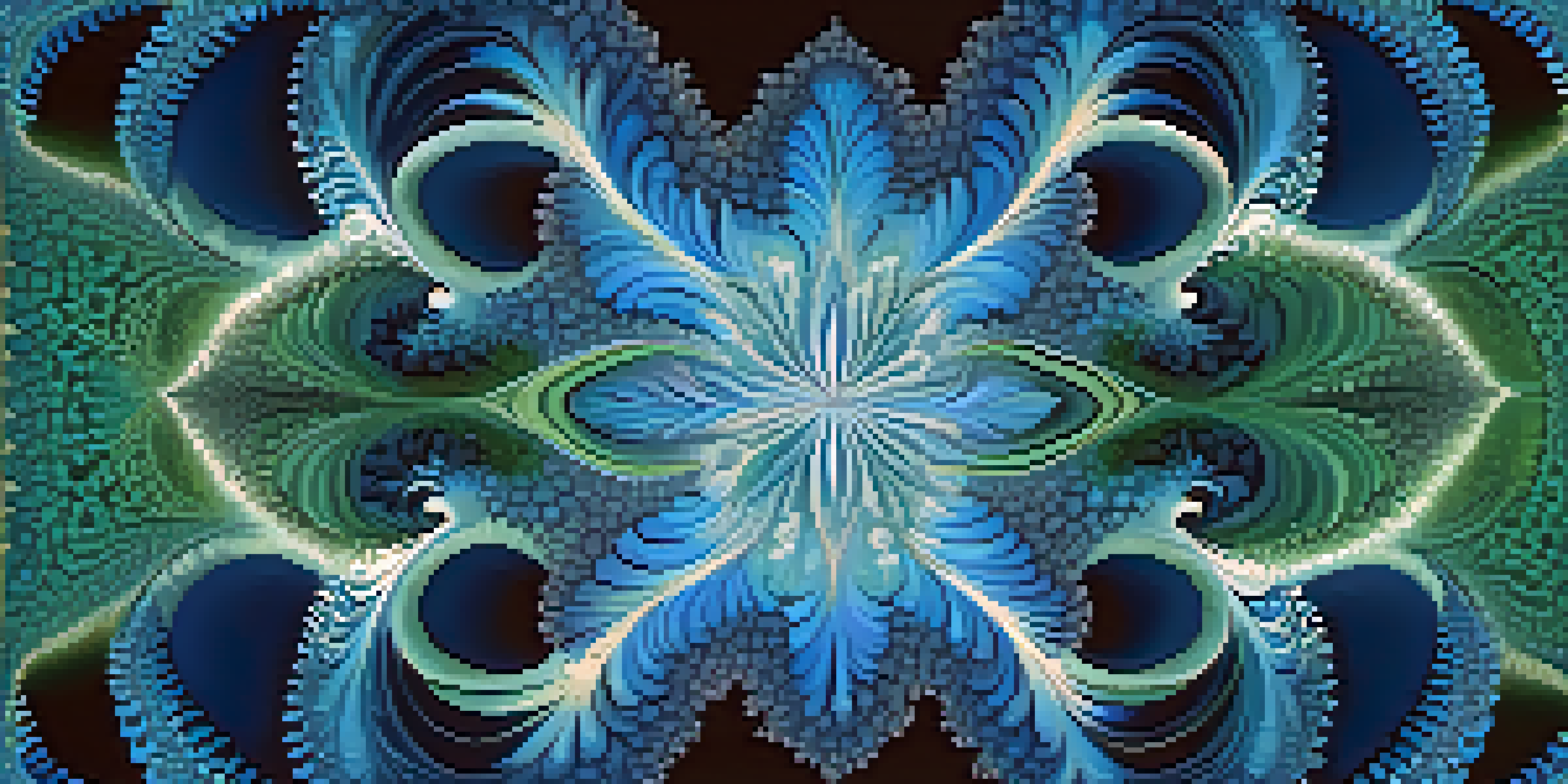Connecting Mathematics and Art: The Beauty of Patterns

The Intriguing Intersection of Math and Art
At first glance, mathematics and art may seem like worlds apart, but they share a deep connection. Both disciplines rely on creativity and structure, making them complementary forces in the universe. Artists often use mathematical concepts to create visually appealing works that resonate with viewers on multiple levels.
Mathematics is the music of reason.
For example, consider the Fibonacci sequence, a series of numbers where each number is the sum of the two preceding ones. This sequence appears in nature, from the arrangement of leaves to the spirals of seashells, and artists like Salvador Dalí have incorporated it into their masterpieces. The harmony created by these patterns captivates us and showcases the beauty of mathematics at work.
By exploring this intersection, we can appreciate how mathematical principles contribute to the aesthetic qualities of art. This connection enhances our understanding of both fields and invites us to look at the world through a more integrated lens.
Patterns: The Language of Nature
Nature is a master at creating patterns, and these patterns often follow mathematical rules. From the symmetry of a butterfly's wings to the fractal geometry of snowflakes, mathematics underpins the beauty we see around us. These natural patterns provide artists with inspiration and a framework to explore their creativity.

Take the example of tessellations, which are patterns formed by repeating shapes without gaps or overlaps. Artists like M.C. Escher harnessed these mathematical concepts to create mind-bending visual experiences that challenge our perception. His works illustrate how mathematics can create engaging, intricate designs that captivate the viewer.
Art and Math Share Deep Connections
Both disciplines rely on creativity and structure, enhancing our appreciation of beauty through patterns and principles.
By observing nature's patterns, artists can not only find inspiration but also create works that resonate with the underlying mathematical principles. This fusion of art and nature allows us to appreciate the beauty that surrounds us and the mathematics that defines it.
Geometric Art: Where Shapes Meet Creativity
Geometric art is another fascinating area where mathematics and creativity intertwine. Artists use shapes, lines, and angles to create visually stunning compositions that often reveal deeper mathematical relationships. This art form can be found in everything from traditional Islamic mosaics to contemporary graphic design.
Art is the most beautiful of all lies.
One notable example is the work of Piet Mondrian, who utilized simple geometric shapes to express complex ideas. His compositions demonstrate how basic elements can come together to create harmony and balance, highlighting the mathematical principles of symmetry and proportion. Through his art, Mondrian invites us to see the beauty in simplicity.
Geometric art not only challenges our perception of space but also encourages us to appreciate the mathematical precision behind these designs. It reminds us that creativity can thrive within structured frameworks, leading to stunning visual experiences.
Fractals: Infinite Beauty Through Recursion
Fractals are a perfect example of how mathematics can create intricate visual patterns that seem infinitely complex. These self-replicating designs, which can be found in nature, art, and even computer graphics, are generated through recursive mathematical processes. They often exhibit a unique beauty that captivates both scientists and artists alike.
The Mandelbrot set is one of the most famous fractals, named after mathematician Benoît Mandelbrot. When visualized, it reveals stunning patterns that repeat at different scales, creating an almost hypnotic effect. Artists have embraced fractals, using them to create mesmerizing digital art that showcases the marriage of math and creativity.
Nature Inspires Mathematical Patterns
From butterfly wings to snowflakes, natural patterns follow mathematical rules that artists can use for inspiration.
By exploring fractals, we can see how mathematics opens up new avenues for artistic expression. This exploration encourages us to appreciate the intricacies of both math and art, revealing how they can enhance each other in unexpected ways.
Symmetry: The Foundation of Aesthetic Appeal
Symmetry plays a crucial role in both mathematics and art, serving as a fundamental principle of beauty. In mathematics, symmetry refers to the balance and proportion of shapes, while in art, it creates harmony and visual appeal. Many artists consciously incorporate symmetry into their works to evoke feelings of stability and order.
Consider the works of Leonardo da Vinci, who employed symmetry in his paintings to create a sense of balance and realism. His meticulous attention to detail and mathematical precision helped elevate his art, allowing viewers to experience beauty in its most harmonious form. This connection between symmetry and aesthetics highlights the influence of mathematics on artistic practices.
As we appreciate the role of symmetry in art, we deepen our understanding of how mathematical principles can enhance our visual experiences. This insight reinforces the idea that beauty often lies in balance, both in nature and in the creative realm.
The Role of Mathematics in Artistic Techniques
Mathematics has significantly influenced various artistic techniques, shaping how artists approach their work. For instance, perspective drawing relies on mathematical concepts to create the illusion of depth and space on a flat surface. This technique allows artists to depict three-dimensional scenes realistically, captivating their audience.
Renowned artists like Raphael and Brunelleschi mastered the art of perspective, using mathematical principles to guide their compositions. By employing vanishing points and horizon lines, they transformed how we perceive depth, creating immersive environments that invite viewers into their worlds. This mathematical foundation adds another layer of depth to their artistic endeavors.
Symmetry Enhances Aesthetic Appeal
Symmetry serves as a fundamental principle in both art and mathematics, creating harmony and visual stability.
Understanding the mathematical techniques behind art can enhance our appreciation for the skill and creativity involved. It serves as a reminder that art is not solely about inspiration; it also involves a thoughtful application of principles that can elevate the final piece.
Embracing the Unity of Art and Mathematics
As we've explored, the connection between mathematics and art is both fascinating and profound. By embracing this unity, we can appreciate the beauty that arises from the interplay of patterns, shapes, and symmetry. This appreciation encourages us to see the world through a multifaceted lens, where art and math coexist harmoniously.
Artists can draw inspiration from mathematical concepts, while mathematicians can find beauty in artistic expressions. This collaboration enriches both fields, fostering a deeper understanding of creativity and structure. The dialogue between art and mathematics invites us to explore new ideas and expand our horizons.

Ultimately, recognizing the beauty of patterns in both disciplines allows us to celebrate the creativity that stems from mathematical thinking. As we continue to bridge the gap between these two worlds, we open ourselves to a wealth of inspiration and insight.